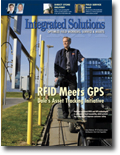RFID In The Field Impacts Customer Experience
Integrated Solutions, March 2010
 It's always interesting to see RFID (radio frequency identification) technology being demonstrated at an event or in a controlled pilot environment. But, there's nothing more striking than a firsthand experience of RFID's impact in a real-world setting. And, recently, that's exactly what I got.
It's always interesting to see RFID (radio frequency identification) technology being demonstrated at an event or in a controlled pilot environment. But, there's nothing more striking than a firsthand experience of RFID's impact in a real-world setting. And, recently, that's exactly what I got.I was lucky enough to visit a ski resort in Colorado. It was heavily trafficked by vacationers trying to squeeze as much skiing into what daylight would allow. That means maximizing time on the hills and minimizing time waiting in lines. Fortunately, the resort had deployed RFID technology. Patrons' ski passes included embedded RFID tags, which contained data related to the dates and times the passes were valid. The staff read the passes by quickly waving Intermec handhelds (enabled with RFID readers) near the skiers as they waited in line. After an audible "beep," skiers moved to the lift. How quick and smooth was the process? Well, I don't even think most of the skiers knew what was happening.
Compare this process to other resorts, and the difference is amazing. Passive RFID technology means patrons don't have to locate passes and hold them up for visual inspection. Eliminating the visual inspections means no chance for human error or skiers overstaying their passes' terms. One resort uses RFID to enhance the customer experience, eliminate staff errors, and maximize revenue. The other resort misses out on all of those opportunities.
Field Technologies Impact Customers
The above is a great example of RFID deployed in an outside-the-four-walls,
challenging environment. But, we could just as easily cite companies that have
deployed mobile handhelds in direct-store-delivery applications or GPS technology
in sales applications or M2M (machine-to-machine) technology in service
applications. Whether your company is managing skiers as they move
throughout a resort or managing employees as they provide a service in the
field, there's really no excuse for not leveraging available technology. While the
technology is transparent to customers, it improves their overall experience
and interaction with your company. And, it also improves your bottom line.
Nothing beats firsthand experience as a teacher. Step outside your company, and see how your competitors use field technologies to manage their processes and customers. Then ask yourself why you're not doing the same.
